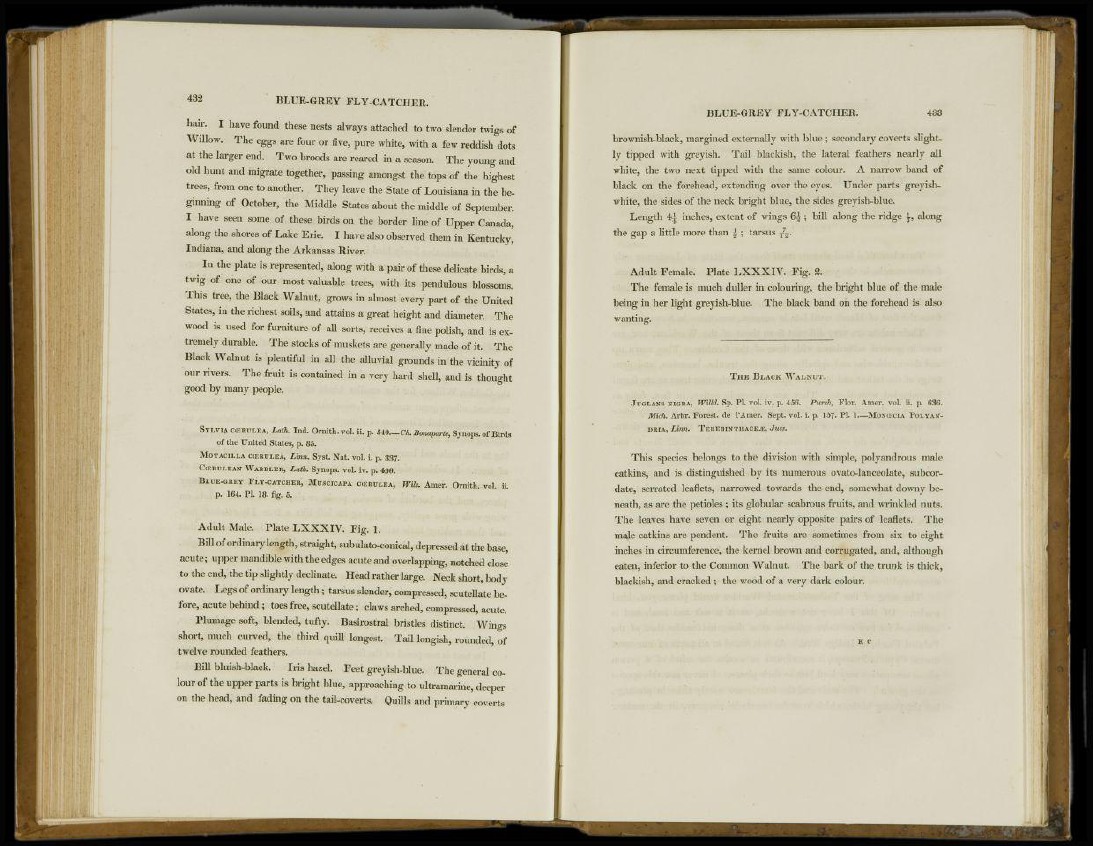
432 BLUE-GREY FLY-CATCHER.
hair. I have found these nests always attached to two slender twigs of
Willow. The eggs are four or five, pure white, with a few reddish dots
at the larger end. Two broods are reared in a season. The young and
old hunt and migrate together, passing amongst the tops of the highest
trees, from one to another. They leave the State of Louisiana in the beginning
of October, the Middle States about the middle of September.
I have seen some of these birds on the border line of Upper Canada,
along the shores of Lake Erie. I have also observed them in Kentucky,
Indiana, and along the Arkansas River.
In the plate is represented, along with a pair of these delicate birds, a
twig of one of our most valuable trees, with its pendulous blossoms.
This tree, the Black Walnut, grows in almost every part of the United
States, in the richest soils, and attains a great height and diameter. The
wood is used for furniture of all sorts, receives a fine polish, and is extremely
durable. The stocks of muskets are generally made of it. The
Black Walnut is plentiful in all the alluvial grounds in the vicinity of
our rivers. The fruit is contained in a very hard shell, and is thought
good by many people.
SYLVIA CCEHULEA, Lath. Ind. Ornith. vol. ii. p. 540—Ch. Bonaparte, Synops. of Birds
of the United States, p. 85.
MOTACILLA c CERÚLEA, Linn. Syst. Nat. vol. i. p. 337.
COZRULEAN "YVABBLER, Lath. Synops. vol. iv. p. 490.
BLUE-GREY FLY-CATCHER, MUSCÍCAPA CERÚLEA, Wils. Amer. Ornith, vol. ii.
p. 104. PL 18. fig. 5.
Adult Male. Plate LXXXIV. Fig. 1.
Bill of ordinary length, straight, subulato-conical, depressed at the base,
acute; upper mandible with the edges acute and overlapping, notched close
to the end, the tip slightly declínate. Head rather large. Neck short, body
ovate. Legs of ordinary length; tarsus slender, compressed, scutellate before,
acute behind ; toes free, scutellate; claws arched, compressed, acute.
Plumage soft, blended, tufty. Basirostral bristles distinct. Wings
short, much curved, the third quill longest. Tail longish, rounded, of
twelve rounded feathers.
Bill bluish-black. Iris hazel. Feet greyish-blue. The general colour
of the upper parts is bright blue, approaching to ultramarine, deeper
on the head, and fading on the tail-coverts. Quills and primary coverts
brownish-black, margined externally with blue ; secondary coverts slightly
tipped with greyish. Tail blackish, the lateral feathers nearly all
white, the two next tipped with the same colour. A narrow band of
black on the forehead, extending over the eyes. Under parts greyishwhite,
the sides of the neck bright blue, the sides greyish-blue.
Length 4^ inches, extent of wings 6 | ; bill along the ridge 1, along
the gap a little more than | ; tarsus y7^.
Adult Female. Plate LXXXIV. Fig. 2 .
The female is much duller in colouring, the bright blue of the male
being in her light greyish-blue. The black band on the forehead is also
wanting.
THE BLACK WALNUT.
JUGLANS NIGRA, Willd. Sp. PL vol. iv. p. 456. Pursh, Flor. Amer. vol. ii. p. 636.
Mich. Arbr. Forest, de PAmer. Sept. vol. i. p. 157- PL 1.—MONCECIA POLYAN1-
DRIA, Linn. TEREBINTHACEJE, JUSS.
This species belongs to the division with simple, polyandrous male
catkins, and is distinguished by its numerous ovato-lanceolate, subcordate,
serrated leaflets, narrowed towards the end, somewhat downy beneath,
as are the petioles ; its globular scabrous fruits, and wrinkled nuts.
The leaves have seven or eight nearly opposite pairs of leaflets. The
male catkins are pendent. The fruits are sometimes from six to eight
inches in circumference, the kernel brown and corrugated, and, although
eaten, inferior to the Common Walnut. The bark of the trunk is thick,
blackish, and cracked ; the wood of a very dark colour.
E e